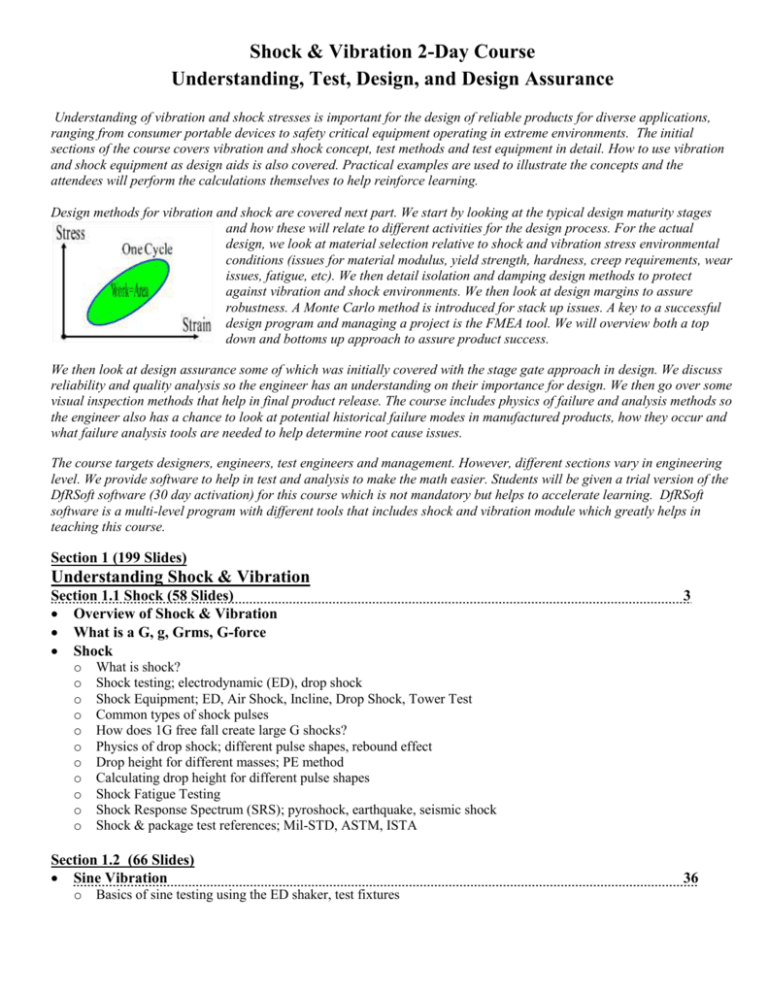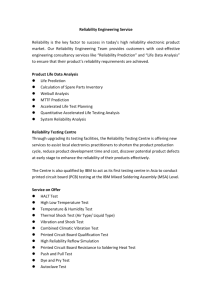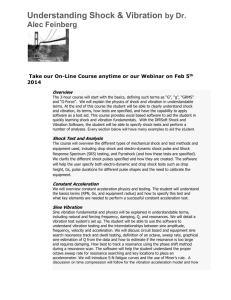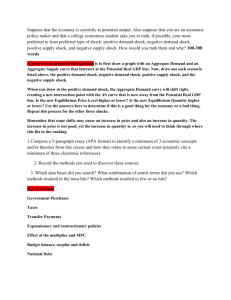Understanding of vibration and shock stresses is important for the
advertisement

Shock & Vibration 2-Day Course Understanding, Test, Design, and Design Assurance Understanding of vibration and shock stresses is important for the design of reliable products for diverse applications, ranging from consumer portable devices to safety critical equipment operating in extreme environments. The initial sections of the course covers vibration and shock concept, test methods and test equipment in detail. How to use vibration and shock equipment as design aids is also covered. Practical examples are used to illustrate the concepts and the attendees will perform the calculations themselves to help reinforce learning. Design methods for vibration and shock are covered next part. We start by looking at the typical design maturity stages and how these will relate to different activities for the design process. For the actual design, we look at material selection relative to shock and vibration stress environmental conditions (issues for material modulus, yield strength, hardness, creep requirements, wear issues, fatigue, etc). We then detail isolation and damping design methods to protect against vibration and shock environments. We then look at design margins to assure robustness. A Monte Carlo method is introduced for stack up issues. A key to a successful design program and managing a project is the FMEA tool. We will overview both a top down and bottoms up approach to assure product success. We then look at design assurance some of which was initially covered with the stage gate approach in design. We discuss reliability and quality analysis so the engineer has an understanding on their importance for design. We then go over some visual inspection methods that help in final product release. The course includes physics of failure and analysis methods so the engineer also has a chance to look at potential historical failure modes in manufactured products, how they occur and what failure analysis tools are needed to help determine root cause issues. The course targets designers, engineers, test engineers and management. However, different sections vary in engineering level. We provide software to help in test and analysis to make the math easier. Students will be given a trial version of the DfRSoft software (30 day activation) for this course which is not mandatory but helps to accelerate learning. DfRSoft software is a multi-level program with different tools that includes shock and vibration module which greatly helps in teaching this course. Section 1 (199 Slides) Understanding Shock & Vibration Section 1.1 Shock (58 Slides) Overview of Shock & Vibration What is a G, g, Grms, G-force Shock o o o o o o o o o o o What is shock? Shock testing; electrodynamic (ED), drop shock Shock Equipment; ED, Air Shock, Incline, Drop Shock, Tower Test Common types of shock pulses How does 1G free fall create large G shocks? Physics of drop shock; different pulse shapes, rebound effect Drop height for different masses; PE method Calculating drop height for different pulse shapes Shock Fatigue Testing Shock Response Spectrum (SRS); pyroshock, earthquake, seismic shock Shock & package test references; Mil-STD, ASTM, ISTA Section 1.2 (66 Slides) Sine Vibration o 3 Basics of sine testing using the ED shaker, test fixtures 36 o o o o o o o o o o o o Sine wave basics; phase effect, track & dwell, resonance & Q, RMS values Sine wave math – amplitude, velocity, acceleration Transmissibility, Q, two graphical methods for Q Harmonic oscillator physics; natural & forcing frequency, academic & real world Q Details of damping, transmissibility Q, resonance Sine amplitude equations with Q factor Estimates of Q when it cannot be measured for systems & components Sweep Rate – Octaves, consequences of too fast a sweep rate Dwell sine testing Sine Fatigue Life S-N Curves, how the b factor effects the acceleration model S-N curves, references Accelerated testing using S-N curve information or historic information Constant acceleration o Section 1.3 (88 Slides) Random vibration testing o o o o o o o o o o o o o o o o o o o 157 ED vs. HALT The HALT Concept Section 2 (58 Slides) Complex System Degradation Analysis Methods o 97 Why random Understanding random frequency & time domain Fourier Transform – White Noise Why sine & random are hard to compare ED vs. repetitive shock Calculating Grms from PSD spectrum; hand and complex calculation using DfRSsoft tool, ED displacement, and max likely velocity PSD slope (dB/Octave) Transportation vibration exposure Random vibration accelerated cyclic testing fatigue life estimation Tri-axial fixturing, X, Y, Z data, tri-axial testing Estimating Q from random vibration data Tri-axial and angular testing Accelerometers Sine-on-random Random-on-random Random probability concepts Estimate of peak acceleration/displacement response - Miles equation Exact method for damage estimation (derivation using thermodynamic work) Miner’s approximation – derivation, why it is an approx., stress concentration HALT Random Vibration 93 High G level testing, G, RPM 4 System level degradation indications & measurements o Thermal degradation o Vibration system noise degradation – Variance method Section 3 (319 Slides) Design Methods for Shock and Vibration 3.1 Design Stages & The Design Process o o Key goals & Filling the Reliability & Quality Gap The three fundamental design assurance activities 3 o o o Design for reliability & quality Reliability & quality verification in design Analytical physics for design 3.2 The Stage Gate approach for successful design o o 20 The design process flow Understanding each gate – the tools for your program 3.3 Material selection stress considerations in design o o o o o o o o o 57 Elastic deformation, yielding and ductile rupture material considerations Creep & cumulative creep fatigue material considerations Excessive wear; friction & lubrication – material selection Cyclic fatigue SN curves – material selection PCB fatigue life Circuit board component fatigue life model analysis –Steinberg Method (sine and random) Thermal cycle fatigue Engelmaier model - solder component selection & underfill effects on thermal fatigue life Four step approach for material selection 3.4 Design Margin Methods o o o 162 Design safety factors Reliability Design Safety Margin - load/strength interference Electrical derating 3.5 Stack Up & Monte Carlo Analysis Methods o o o o o 197 Stack up Worst case stack up analysis Spring rate stack up Monte Carlo Methods for stack up Monte Calro Methods for spring rate stack up 3.6 Isolation & Damping - Designing for Vibration & Shock Suppression o o o o 224 Vibration Isolation Shock Isolation/Absorption Packaging guidelines - foam thickness Vibration Absorption 3.7 Failure Modes Effects Analysis (FMEA), Design Methods o o o o o o 274 Why FMEA Team approach Top-down for DfRQ product program planning Bottoms up FMEA Design FMEA Top down FMEA for program planning 3.8 Visual Inspection –An important design release tool 311 Section 4 (144 Slides) Physics of Failure and Failure Analysis – Lessons Learned for Better Design 4.1 Physics of Failure, 7 step problem solving method o Skills of the Failure Analyst o Failure Analysis reporting – Lessons learned database 4.2 Physics of Failure – Types of Aging, Diffusion, Corrosion, Migration o Three main types of aging o Diffusion o Intermetallics - Gold embrittlement, Kirkendall effect, Puple plague o Corrosion o Ag Migration 2 17 4.3 Physics of Failure – Mechanical Failure, CTE Mismatch, Solder Issues o Modes of mechanical failure o Stress-strain o CTE Mismatch & thermal fatigue in solder joints o Various failures – related to creep, BGA, Caps… 4.4 Physics of Failure – Solder Intermetallics, Platting, Contamination, Non Wetting, Coverage o Solder intermetallics o Plating contamination o Non wetting o Solder coverage 4.5 Physics of Failure – Lead Free Issues, ESD, Overstress o Lead Free Issues o ESD & Electrical Overstress 73 96 116 Section 5 (138 Slides) Reliability & Quality Design Assurance Tools 5.1 Basic Reliability Mathematics 4 o MTBF/Time independent failure rate basics o Reliability conversions o o o o System reliability analysis Block diagrams Redundancy K of N Reliability allocation 5.2 Advanced Reliability Mathematics o o o 5.3 Design maturity testing o o 85 Arrhenius temperature model Temperature-humidity model Coffin-Manson Thermal Cycle Model Modified Coffin-Manson Model Vibration Acceleration Model - Sine or random General Power Law Model Accelerated statistical confidence testing 5.5 Environmental profiling o 73 DMT Stage Gate Statistical confidence – Chi-squared confidence 5.4 Accelerated testing & Models o o o o o o o 37 Time dependent failure rate Key reliability functions; CDF, PDF, hazard rate Reliability Life Data Analysis Methods (Weibull…) 99 CALT like analysis method using DfRSoft methods Products that are used at various stress level-how to profile them to one stress level equivalence o Using profiling to target your design and for accelerated testing targeting 5.6 MTBF Reliability Predictions 5.7 Quality Aids in Design Assurance o Basic tools in quality design o Cpk o Normality analysis o Yield 103 112 Course, Instructor Biography Instructor: Alec Feinberg, founder of DfRSoft Alec has a Ph.D. in Physics and is the principal author of the book, Design for Reliability. He is also the author of the software package DfRSoft, which is used worldwide. Alec has provided reliability engineering services in all areas of reliability and on numerous products in diverse industries for over 35 years that include solar, thin film power electronics, defense, microelectronics, aerospace, wireless electronics, and automotive electrical systems. He has extensive expertise in the area of shock, vibration, and HALT test and analysis methods in working on Military and Commercial products. He has provided training classes in Design for Reliability, Shock and Vibration, HALT, Reliability Growth, Electrostatic Discharge, Dielectric Breakdown, DFMEA and Thermodynamic Reliability Engineering. Alec has presented numerous technical papers and won the 2003 RAMS Alan O. Plait best tutorial award for the topic, “Thermodynamic Reliability Engineering”. He is currently an invited author to contribute on a new book on the Physics of Degradation in Engineering Devices and Machines due out early next year. Alec is based in Raleigh, North Carolina. Enrollment Send purchase order to: DfRSoft 9510 Centerwood Dr. Raleigh, NC 27617 Email: support@dfrsoft.com Payment Method by purchase order, paypal or credit card) For further information, please call Dr. Alec Feinberg at 617-943-9034. On-Site Company Cost Information (same price as on line for >5 people call or email) o o o o Two day course - $950 Per Peron (Min. 4 people of $3800 payment) Note 5-10 people, $850 No Extra Cost (i.e. DfRSoft pays for its travel expenses) Optional - Design for Reliability & Quality Software $240 ($50 discount, Free Trial copy included for class)






